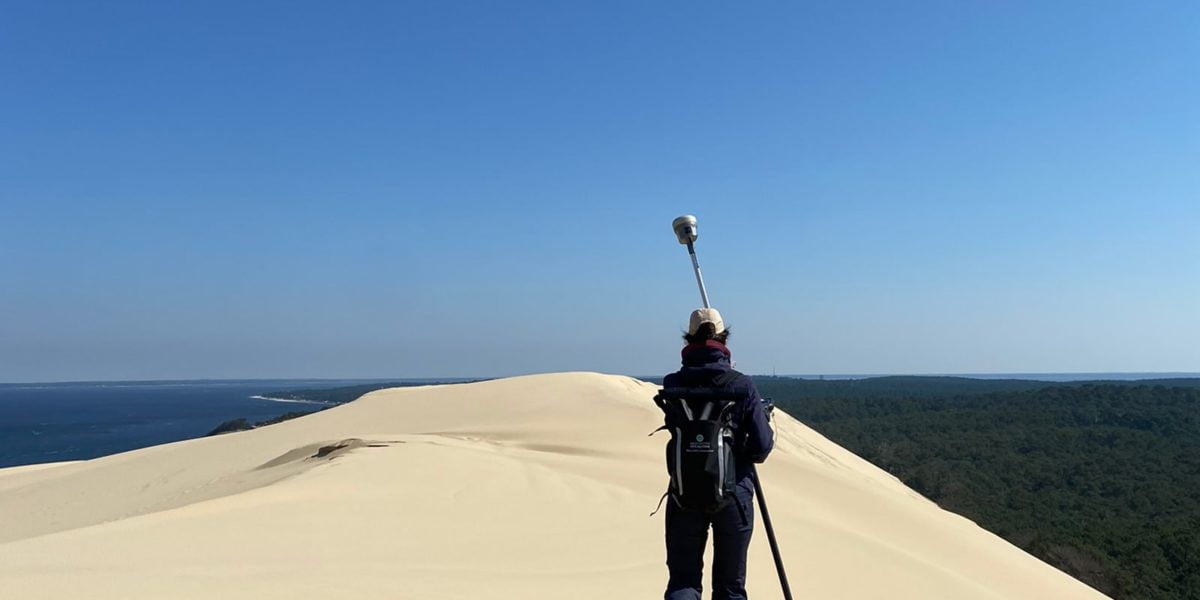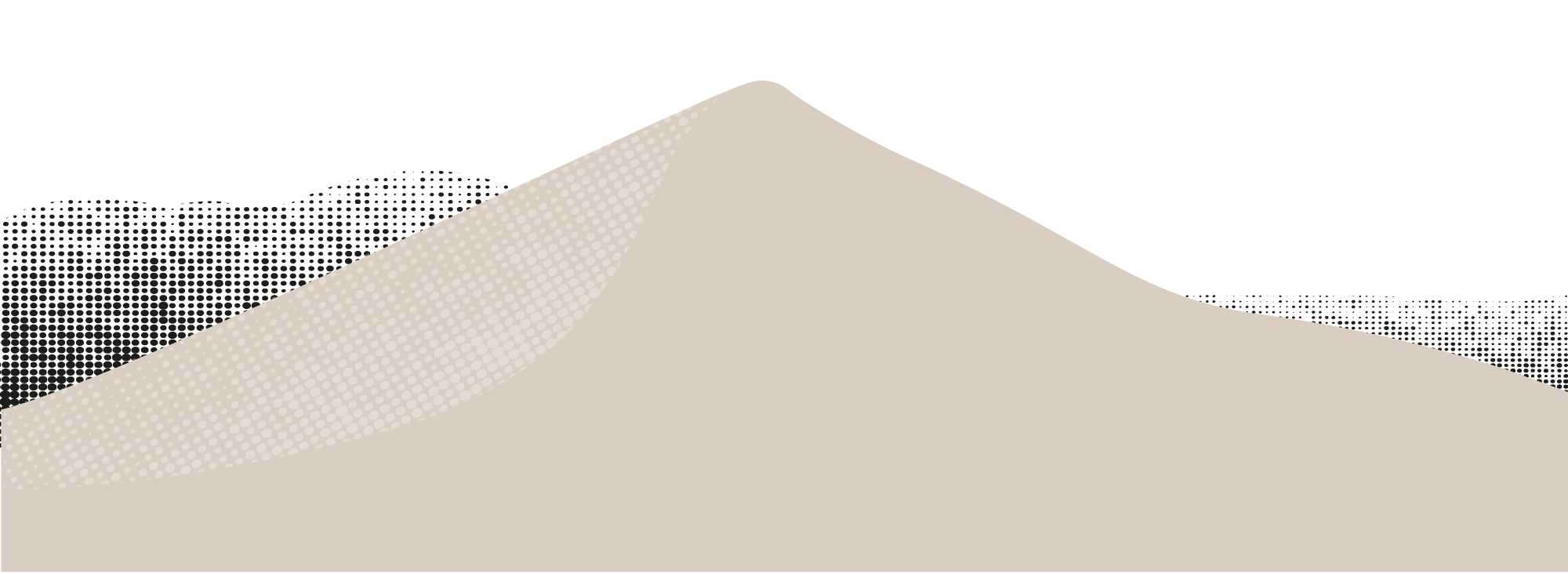They are, in a way, the “guardians of the Dune”. Engineer, botanist, landscaper ... and many experts find here an inexhaustible field of study and exploration. So much knowledge to pass on so that everyone becomes aware of the issues related to the preservation and management of this moving natural monument.
Video and image credits: @Midiprod
Audiovisual production: @Opixido, Maxime Morin and Magalie Fargeas
Portraits
Jean-Marie Froidefond, Geomorphologist and former researcher at CNRS and CNEXO
Jean-Marie Froidefond has been studying the dune since 1970. He is also the author of the book The Great Dune of Pilat – The mysteries of the highest dune in Europe.
What does the Dune du Pilat Grand Site represent for you with its landscape components?
The Dune du Pilat presents a unique relief in Europe, by its dimensions and by the fact of being the only large unvegetated dune, not fixed by vegetation. For me, as a geologist, this is a unique example.
It is an exceptional relief which has proven to be very interesting to study because we are led to understand the formation and movement of the dunes of the Aquitaine coast.
When I completed my thesis, I was very surprised because the dune had already existed for 70 or even 80 years at this altitude. And at the time, I told myself that it was going to disappear. But in reality, it is still there. We thought it would gradually decrease in altitude. There were indeed attempts at revegetation in the 1900s, but in vain. We wanted to stop the dune from moving inland. Ultimately, nature has been well preserved, despite its movement of 4 to 5 meters per year. Proof that nature has a life of its own.
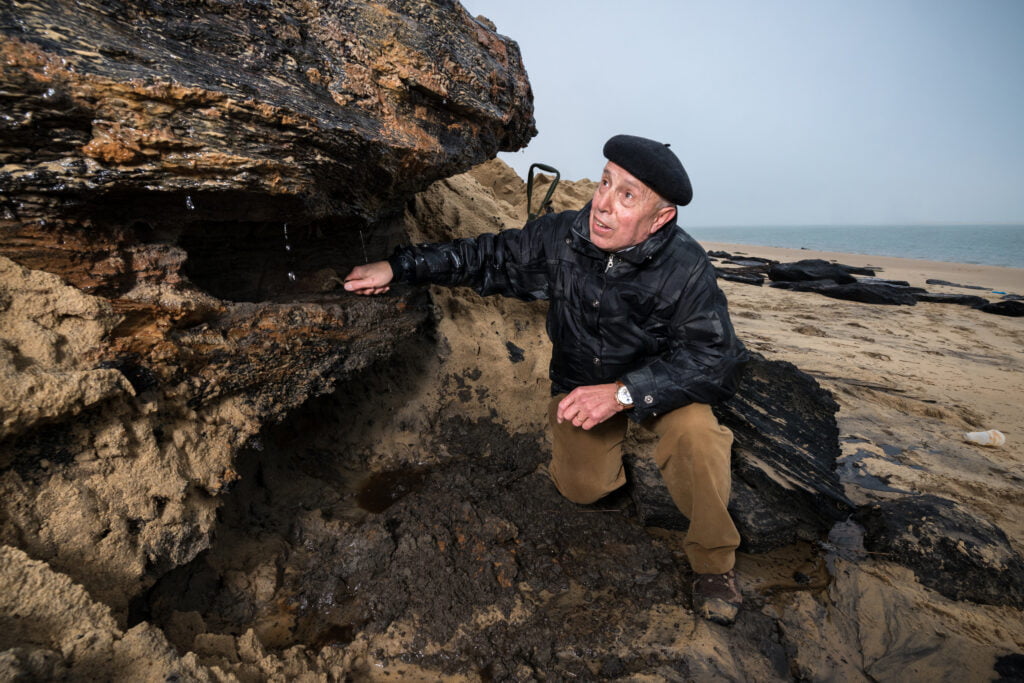
Can you present your work on the Dune du Pilat? What is your contribution to the preservation and management of the Grand Site de la Dune du Pilat?
This is divided into two points.
First of all, this concerned the identification of the 4 main paleosols which are found under the dune and which make it possible to reconstruct the general history of this dune formation and also to understand the different phases of occupation of the coastline by the dunes, from the Middle Ages to the present day. Ultimately, we observe not only different paleosols which testify to the invasion of dunes on the coast but also different periods of vegetation. This constitutes my most important contribution. I demonstrated how this dune was formed and the different phases of occupation of the coastline by this coastal dune.
My second contribution is more recent (2014 or 2015). I focused on the very particular vegetation found at the foot of the dune. I was surprised because we have both plants that normally live in fresh water and others that tolerate salt water. The result is astonishing. Here is the explanation: at the top of the beach, there is both fresh water coming from inland, which circulates under the dune. Given that there are impermeable layers at this location, the water does not penetrate, it bypasses these layers and circulates under the dune. Before re-emerging at the top of the beach. At the same time, we have the waves which die on the beach, reach the foot of the dune and bring salt water. This is why we have both types of vegetation. Which is fun and amazing. This vegetation has adapted very well, contrary to what one might believe.
This zone of vegetation which is located at the foot of the dune is progressing. It is denser now than 50 years ago. It is more important and can play a role because the sand from the beach will not be able to feed the dune. This may cause its height to decrease. But I can't say for sure. In reality, the dune is fed by its own sand, which reaches the top. The Arguin bench has never fed the dune. This is completely false.
First, dunes are formed by sand carried by the wind. And this sand is transported when you have a perfectly horizontal surface. It is transported to a height of 15 to 20 centimeters maximum and over a length of around one meter maximum. The Banc d'Arguin is located 500 meters from the dune so the grain of sand falls into the water. Once in the water, it can move either towards the inside of the basin or outwards depending on the flood currents (current generated by the rising tide) and ebb currents (current created by the falling tide). But they do not feed the Dune du Pilat. The banks would have had to move to the foot of the dune to feed it.
Second, the grains of sand on the beach rise up the dune if the slope is not too steep. But it is mainly the grains of sand from the dune itself which are transported by the wind towards the summit. And it is these grains of sand which accumulate at the summit and which can increase or decrease its height depending on the climate and the weather. Then these grains of sand fall on the other side. Except when there is a lot of wind, the grains of sand that arrive at the top can be carried quite far and not return to the rear part of the dune. But most often, we see sand avalanches on the east side, on the forest side.
She loses volume, but not that much. That's why she's still here.
What message would you like to convey to visitors?
The first is that nature offers a very beautiful landscape. Fortunately, a mixed union has been created and the site is protected. This clearly shows that a protected natural site can attract a lot of people and that ultimately it is the protection of the environment which is an important asset for the population and visitors. An example: I climbed to the summit once on New Year's Day. The weather was very good, there were people there, people were very happy and some had brought a bottle of champagne. I found it good. This place is beautiful, with a very beautiful landscape and it is important to highlight it and not prevent people from enjoying it.
The second message is that the preservation of nature is a very important asset for the population, for their health, for their pleasure. From this natural phenomenon, we can learn a lot about History. This also allows us to see that by observing the Dune du Pilat, and even other phenomena, we are witnesses to natural evolution.
The second message is that the preservation of nature is a very important asset for the population, for their health, for their pleasure. From this natural phenomenon, we can learn a lot about History.
Do you think that public management carried out for more than 15 years contributes to this sought-after balance between preservation of fragile natural spaces and quality of public reception?
Absolutely, yes. I knew the dune before the creation of the Mixed Union. People parked randomly. You should know that before, people were not at all interested in the dune. Interest arose especially after the Second World War. Before, the dune represented more of a nuisance and people tried to cover it with plants, with maroons in particular. They were trying to stare it down because it was starting to encroach on their property. This craze for this part of the dune is therefore quite recent. But before the Mixed Union, it was a mess, it was quite anarchic. People stopped randomly and climbed onto the dune without any information, of course, about its formation.
The Union has obviously provided parking with a well-channelized parking system. The place is more secure in terms of car traffic and visitors who come to climb it.
There is also land security. Before, it would have been possible to see people setting up restaurants almost anywhere and anyhow. At the foot of the dune, we could have seen wild car parks growing to the right or left.
The vegetation found at the foot of the dune, on the forest side, is quite particular and may interest people. There are places, for example, where we find a lot of arbutus trees that we don't find elsewhere. There is a kind of microclimate at the foot of the dune, in certain places, particularly on the north side, towards the La Grave site. There is particular vegetation there and I think there is a slightly wetter area there, since the dune acts as a bit of a rampart. So vegetation is likely to develop on that side. On the other hand, on the ocean side, it is not easy to publicize the vegetation found there. It's further away. On the land side, it's simpler, especially since there are many important species. There are 4 or 5. But it's already a good thing to explain to them that one tree is a maritime pine, another is a pedunculate oak, an arbutus tree or even an bracken fern. It is important to share the basics of the vegetation in this area. She is really typical. You have to know how to interest visitors and keep them for a long time. You have to try to keep visitors for several hours, so that they enjoy it and are not impatient to leave.
What would you like to add that you have not expressed through these 4 questions?
We can talk about the passes, which are dangerous, in which shipwrecks have unfortunately occurred because the currents and swells can be very strong there. It is very dangerous to enter and leave the Arcachon Basin.
Visitors wonder a lot about the origin of this dune. Why here, in this place? Let's talk about it. Even if it's not easy to answer. The sand of the Aquitaine coast is moved by the swells which then form a current which transports the sand from the north to the south. The sand at the entrance to the Arcachon Basin encounters tidal currents which slow down this transport of sand from north to south. This creates a greater accumulation of sand in the passes. Hence the presence of sandbanks. These benches can at some point stick to the beach. For example, the Pinot bench came to stick to the south of the dune in the 1940s and 1950s. In this case, we are not sure of an impact on the formation of the dune. Let's just say that there is a significant accumulation of sand at this location because the passes slow down the movement of littoral drift.
For the little anecdote, we can also mention the colors visible at the foot of the dune, orange sands. This comes from the fact that fresh water is very rich in iron oxide. It colors the grains of sand. Let's also talk about the freshwater diatoms that we find in the middle of the dune and which raise questions. The archaeological discoveries are also very surprising. Some show that men harvested salt. This means that at one time the sea was there. Some ocean movements are imperceptible.
Nathalie Madrid, Delegate of Rivage Aquitaine, within the Conservatoire du littoral
In 2017, Nathalie Madrid joined the Conservatoire du littoral, taking responsibility for the Aquitaine delegation, which has been engaged since 1998 in a land acquisition policy in order to guarantee the maintenance of public space while permanently protecting the Grand Site from the Dune of Pilat.
What does the Dune du Pilat Grand Site represent for you with its landscape components?
"One of the largest natural sites in France"
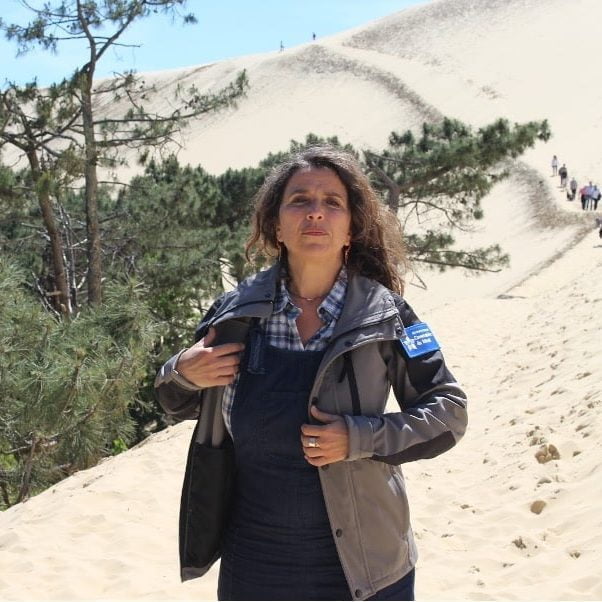
C’est l’un des plus grands sites de la région Nouvelle Aquitaine, voir l’un des plus grands sites naturels de France, de part ses dimensions qui sont, pour les plus connues physiques mais aussi et surtout géologiques, historiques et culturelles. Au-delà de son aspect monumental, il faut s’intéresser au “monument ” géologique qui mérite, à ce titre, d’être respecté. C’est un processus de formation totalement atypique sur le littoral aquitain, une dune en mouvement permanent, unique en Europe. On trouve habituellement ce type de dune en bordure de zones désertiques.
Can you present the impact of your work on the Grand Site de la Dune du Pilat?
"A role of acquisition and management"
The main action of the Coastal Conservatory on the Great Site of the Dune du Pilat is, as everywhere else on the French coast, to acquire land holdings in order to guarantee current and future generations access to these natural spaces and limit its artificialization. For several years, an intervention perimeter has been decided which commits us to acquire all the natural plots within it, whether they are in dune or wooded areas.
La seconde mission du Conservatoire est d’assurer la mise en place d’une gestion publique pérenne de ses terrains car l’objectif n’est pas de les soustraire au public bien au contraire ! En tant qu’opérateur foncier, l’établissement pour lequel je travaille confie donc la gestion de ses propriétés à un acteur public local et l’accompagne dans la définition d’une stratégie à mettre en œuvre. Déclinée en plan de gestion, cela devient la « feuille de route » commune. Le Syndicat Mixte de la Grande Dune du Pilat a été désigné en 2012, gestionnaire pour toutes les parcelles acquises progressivement par le Conservatoire sur le site de la Dune du Pilat. Aujourd’hui cela représente environ 600 hectares. Tous les ans, nous nous réunissons avec l’ensemble des partenaires locaux pour procéder à une évaluation de l’impact des éléments du dispositif de gestion et les adapter si besoin.
Beyond restoring the acquired plots and fighting against the trivialization of places, management also includes the regulation of uses which are diverse. On the Dune, they are essentially sporty and fun (practice of free flight, boarding for sea crossings, hunting, hiking, etc.). It is also a question of organizing, managing and supervising the flows generated by these activities so that they can, at least for those compatible with the sensitivity of the site, continue. Their regulated framework makes it possible to meet the primary objective of the Conservatory, namely to preserve natural spaces and their biodiversity. On the Dune, these are actions yet to be undertaken with our manager. They will be facilitated by new acquisitions.
The scientific monitoring carried out by the Syndicate are real management tools and provide valuable information on the flora and fauna established on the grounds of the Conservatory. Let us not forget that the reconquest of biodiversity is at the heart of our mission.
What message do you want to convey to visitors?
"Be amazed but respect"
Visitors should come here with respect for this unique place. That they consider it as a natural space with incredible landscape components and not as a tourist attraction.
“It is a dune of blond sand, in a green and blue setting, a nugget between sea and forest, a jewel of the French coast”.
What is your view on the 15 years of public management?
"Balanced management"
The Syndicat Mixte, with the Conservatoire du littoral, and the partners who are aware of the fragility of this site and of the need to put in place a lasting policy, leads real balanced actions to achieve the fragile balance between preservation of natural spaces and reception of the public. Today, all the fundamentals (land management, regulatory frameworks, partnerships, awareness-raising actions, improvement of reception facilities, etc.) are in place to sustainably pursue actions in favor of enhancing the Grand Site. Our manager got heavily involved and showed consistency in action.
Many think that trampling accelerates the advance of the dune and degrades it, but in the face of natural elements and in particular the action of the wind, this is not the case. The public can be numerous because the management tools are in place and effective. The challenge today is the preservation of the “green” component of the Grand Site. It is the forest area that suffers from illegal parking and uncontrolled pedestrian traffic creating a risk of fire (following the fire in summer 2022, access to the forest area and illegal parking are strictly prohibited).
Even if this does not fall within its competence or its obligations, the Syndicat Mixte has taken up this subject. It had to be done and it was done. Today, the management of peaks in attendance during the summer is dealt with at the scale of the territory, in a global approach involving all public actors. We need to diversify modes of locomotion and welcome more qualitatively visitors coming by bicycle, public transport or using shuttles from a relay car park.
The mixed union played a leading role on this file but on many others during this decade and today the manager of the Large Site is taken more into consideration. It is the confirmation that we must continue the actions undertaken which sometimes, often, take place over time, over several years.
What would you like to add that you would not have expressed when answering the previous 4 questions?
"A decisive turning point"
It's about being up to the task of turning the corner together. All public actors and partners must come together and work in the same direction to define tomorrow's objectives to ensure the future of this site which leaves no one indifferent.
Aurelien Caillon, Botanist within the South Atlantic National Botanical Conservatory.
Since his arrival in Gironde in 2011, Aurélien Caillon has been the botanist referent for the inventory of the flora of Gironde as well as for invasive exotic plants in New Aquitaine.
What does the Dune du Pilat Grand Site represent for you with its landscape components?
When I first discovered the Dune du Pilat, I absolutely did not expect to find such a geological formation. On its crest, I felt a feeling of vastness.
It feels like a big surprise, you wouldn't expect it to be so big and so vast.
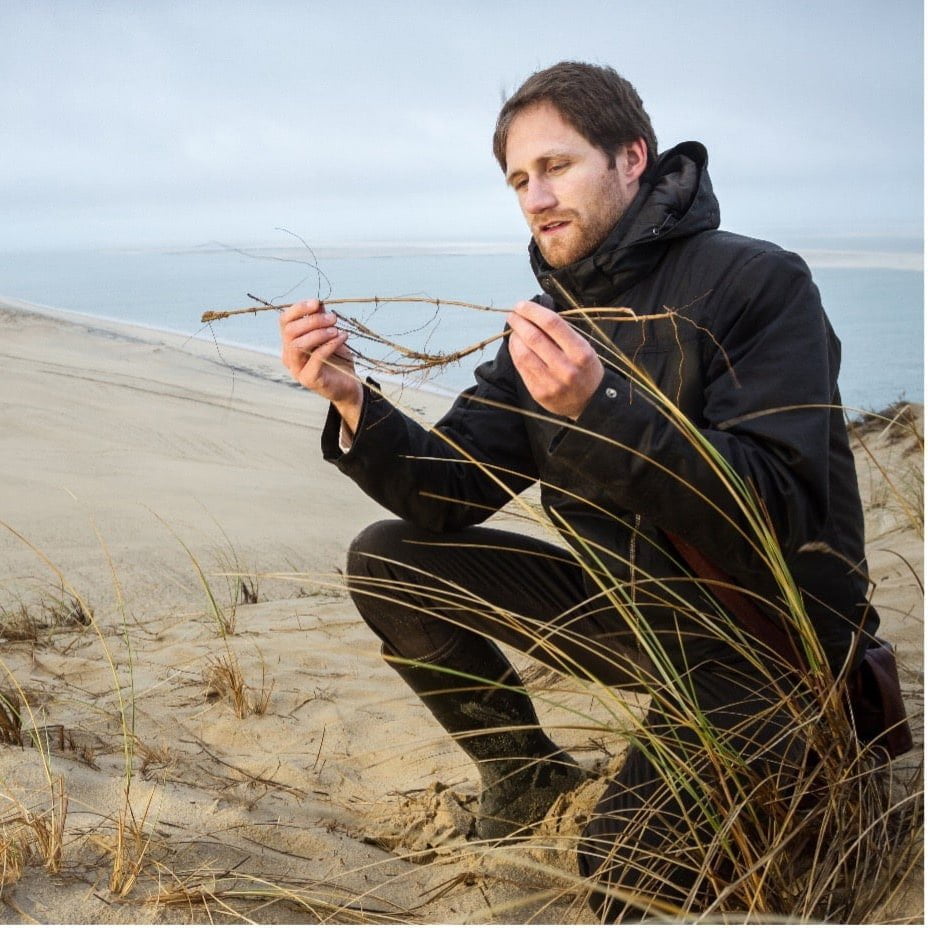
After working on the subject for a few years, I now see it as a book, telling a multitude of stories. It is a real natural heritage with its animal, plant, fungal, lichenic and geological components.
At first glance, the environment appears hostile, desert, uninhabited. On the contrary, populations lived here (the landscape was quite different), before the Middle Ages! The landscape there was of course very different. It is fascinating to imagine that when visitors arrive at the dune crest, they are at the top of a mille-feuille, made up of several geological layers that bear witness to ancient dunes, forests, and lakes ...
My vision as a botanist encompasses the entire Atlantic dune massif. The latter offers a place of transition and refuge for many animal and plant species, many of which are endemic to the South Atlantic coast.
Can you present the impact of your work on the Grand Site de la Dune du Pilat?
The role of the South Atlantic National Botanical Conservatory (CBNSA) aims to acquire knowledge relating to the state and evolution of wild flora and natural habitats according to scientific methods. This involves the identification and characterization of rare and endangered plant species, but also of more common ones and sometimes invasive exotic ones.
Floristic inventories, research for rare species and use of bibliographic resources are all methods deployed to better know, understand and preserve our plant heritage. The ultimate objective is to ensure the conservation of this plant heritage.
My prospecting work on the dune of Pilat started in 2011. These inventory and sampling work consisted in drawing up an inventory of the plant diversity present on the Dune.
At the end of this work, a real partnership was born between the Botanical Conservatory and the manager of the Grand Site. My role for several years has thus consisted of supporting the Dune teams in setting up monitoring of the flora and its habitats. These regular inventories have made it possible to clearly identify the wild flora of the Dune: emblematic species such as the Oyat and the Immortelle des dunes, atypical species such as the common reed, the ribbon tree or the red willow (specific to wetlands), rare and protected species such as the famous thyme-leaved toadflax, Port Silenus and Dune Hawkweed or those considered to be invasive exotic: Pampas lily of the valley or Garlic ...
Our goal: to follow the evolution of flora and habitats on a constantly moving dune! But also put in place a management plan adapted to the challenges identified. In which sectors and which species should we intervene? Where should protective islands be positioned to avoid any trampling? What invasive species should we manage…?
On the Great Site of the Dune of Pilat, the Botanical Conservatory has recommended monitoring and quantifying the number of individuals of the species identified, then mapping the habitats on the dune.
“Through its support role, the Botanical Conservatory allows the Mixed Syndicate to set up appropriate preservation methods for certain species or certain sites. For example, the Gaillouneys site is very rich in remarkable heritage species, many of which are protected. It is essential to identify sensitive areas (reservoirs of biodiversity, etc.) where visitors must be channeled more to avoid too much wandering ”.
What message do you want to convey to visitors?
Enjoy the scenery and pay attention to everything around you. Listen to your senses. Observe. Soak up yourself.
I invite them to have the curiosity to move around, to take a closer look at this vast natural landscape which seems to be in slow motion, while it teems with life, at certain times of the day. You have to spend time there, take advantage of this time and this timeless space that nothing freezes. Nature offers us an incredible spectacle of which everyone is the guarantor. Nature imposes itself on us, and it's intense.
Then, I call on everyone to be accompanied by a cultural mediator during a visit. I am convinced that the vast majority of visitors who took part in these activities discovered a myriad of new and exciting information! For example, do you know the Dune Panicaut's strategy to disperse its seeds? Do you know the endemic insect infested with the thyme leaf flax? How do plants resist drought, strafing by sand, the constant movement of the dune?
What is your view on the 15 years of public management?
“An objective of preservation”
The creation of a public management structure, the Syndicat Mixte, made it possible to raise awareness of the major issues linked to this exceptional natural space, via the web, social networks, the messages transmitted during the guided tours offered to the public. .
Everything is done to channel and educate visitors. Regular checks are carried out to reduce activities that can harm flora or fauna, such as campfires in the woods.
Without the creation of the Joint Union, there would have been no real management of flows, with “wild” parking causing damage to natural environments. The role of the manager is to inform visitors, support them and raise awareness. The Pilat dune is one of the emblematic French tourist sites and attracts 2 million visitors each year. It is important to maintain the good state of conservation of the dune alongside ever-increasing visitor numbers. The mixed union also makes it possible to convey this message about the issues and to channel the flow of visitors.
What would you like to add that you would not have expressed when answering the previous 4 questions?
“A source of knowledge”
I invite everyone not to see the Dune of Pilat as a desert. It is essential to make known all this diversity and all the interactions that species have with each other. “Relocate yourself to this ecosystem as a human being and an animal. We have to learn to look in order to respect what surrounds us ”.
Knowledge is an essential foundation, allowing the implementation of actions of protection, conservation and reception of the public. Communication on these different aspects, which can sometimes seem sharp, scientific and a little too technical, is however fundamental.
The New Aquitaine Coast Observatory
TheNew Aquitaine Coast Observatory is an observation, decision support and knowledge sharing tool for the management and prevention of the risks of erosion and submersion of the constantly evolving neo-Aquitaine coast.
Coastal risks engineers, specialists in extreme events and coastal geomorphology, work at the service of all coastal public stakeholders by traveling very frequently in the field.
What does the Dune du Pilat Grand Site represent for you with its landscape components?
The Dune du Pilat is a unique environment on the entire sandy coast of New Aquitaine. As part of its monitoring program, the Observatoire de la côte de Nouvelle-Aquitaine considers this very special site as a separate object of analysis due to its exceptional dimensions, but also the problems of erosion and dune migration which are very specific to which it is exposed.
The rhythm of this migration, from West to East, that is to say this progression towards the forest which finds itself buried, is perhaps the fastest that can be observed on the sandy coast of Neo- aquitaine.
This phenomenon is partly due to the shape of the dune, to its overall geometry. It is an asymmetrical dune with a very steep slope on the eastern side (forest side).
The Dune is subject to much greater wind dynamics than on the rest of the sandy South Atlantic coast, which is largely made up of white or gray vegetated dunes. The absence or scarcity of vegetation on the sectors of the Dune du Pilat most exposed to wind dynamics contribute to making this monument of sand extremely mobile.
This dune is unique because, unlike the other dunes on the coast, public action is not aimed at curbing its mobility. Elsewhere we plant to stabilize, here we observe its evolution, we analyze and we adapt.
All these elements make the Dune du Pilat a unique system, which we follow as an object in its own right.
What is the impact of the work of the Geological and Mining Research Office on the Dune du Pilat Grand Site?
The Bureau of Geological and Mining Research (BRGM), the Observatory's main technical operator, is interested in the geomorphological evolution of the Pilat dune. Since 2009, the dune has been the subject of annual measurements on the basis of GPS and lidar (airborne laser) surveys which make it possible in particular to assess the retreat of the coastline (the limit between the land and the sea), the line of ridge and the limit between the dune and the forest.
These 3D modeled data help highlight areas of erosion and accretion that are quantified. The evolution of the altimetry is also observed as well as that of the vegetation.
All these elements collected give indications on the future of the Dune but also provide information on its past. This data is valuable for managers.
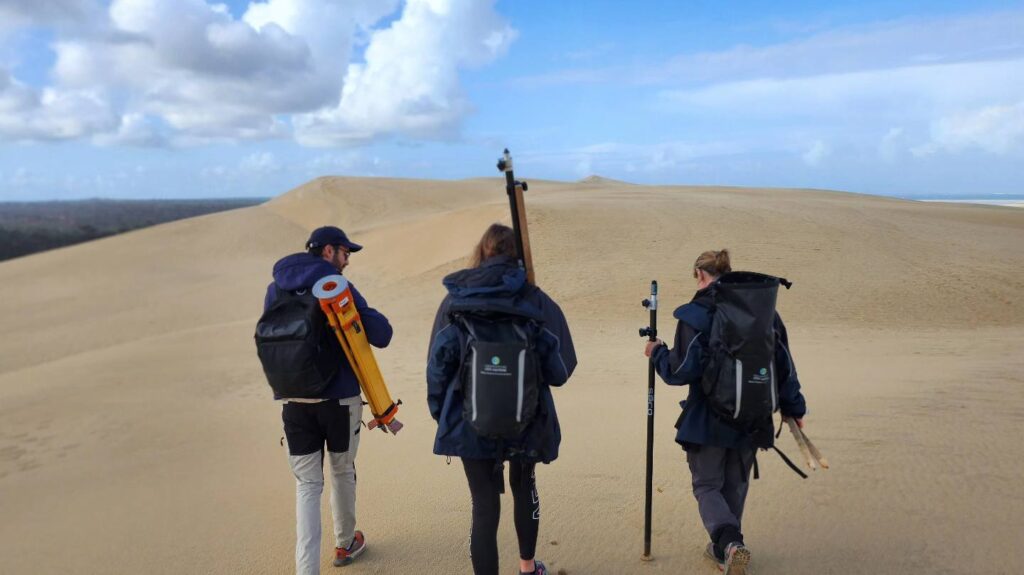
What message does the BRGM wish to convey to visitors?
It is an exceptional natural site which is really, really unique.
You have to realize that it is an extremely mobile environment. We observe there, all the power of nature, which takes back its rights, and occupies the space. Nothing is fixed here. We must always remain humble in the face of nature.
What are our views on 15 years of public management?
Given the tourist flow that there are every year on the site, the environment remains very preserved. Everything is channeled well enough to keep the flow contained. Arrival is mainly through the reception area and the majority of visitors stroll around the staircase installed to facilitate the ascent.
From an outside point of view, it is fairly well put together, so that the setting is preserved, and despite all this remains very attractive for tourists. It's quite remarkable.
We need to talk more about the preservation of a natural site of this quality and anticipate its evolution in order to carry out effective and sustainable management. We must perpetuate the public management of such spaces, it is important.
Bertrand Follea, Landscape designer, within the Folléa-Gautier agency
Bertrand Folléa est paysagiste urbaniste au sein de l’agence Folléa-Gautier. Il est aussi responsable de la chaire Paysage et Energie à l’Ecole nationale supérieure de paysage de Versailles-Marseille et Paysagiste Conseil de l’Etat. Il a reçu le Grand Prix national du paysage en 2016.
Since 2018, after having carried out a landscaping expertise mission at the request of the Mixed Syndicate, Bertrand Folléa has supported, as a consultant landscaper, the manager of the Large Site on major development projects during the pre-operational and operational phases and brings its contribution to the strategic thinking undertaken.
What does the Dune du Pilat Grand Site represent for you with its landscape components?
In the 20th century, Julien Gracq described the Dune du Pilat as:
"Nowhere in France do the great natural elements (...) present themselves as here in large simple and homogeneous masses, of a purity that one would say native"
Despite the few decades that have passed between Julien Gracq and us, we still find today this very great simplicity of the landscape: the forest, the sand, the sea. Very few elements follow one another, and it gives an impression virginal in nature. As if, the sea, the sand, and the forest had always been there. As if, these environments had not been transformed so much by man.
The colors are simple too: blue, white, green. Again, this simplicity gives an impression of remarkably unspoiled nature.
The other particularity of this natural site is its spectacular dimension, out of the ordinary. Everything is immense: the forest runs as far as the eye can see, the ocean stretches out to the horizon, and we walk on a giant pile of sand. It is an originality which is truly unique.
We are on this kind of unusual white slice that separates two very vast oceans.
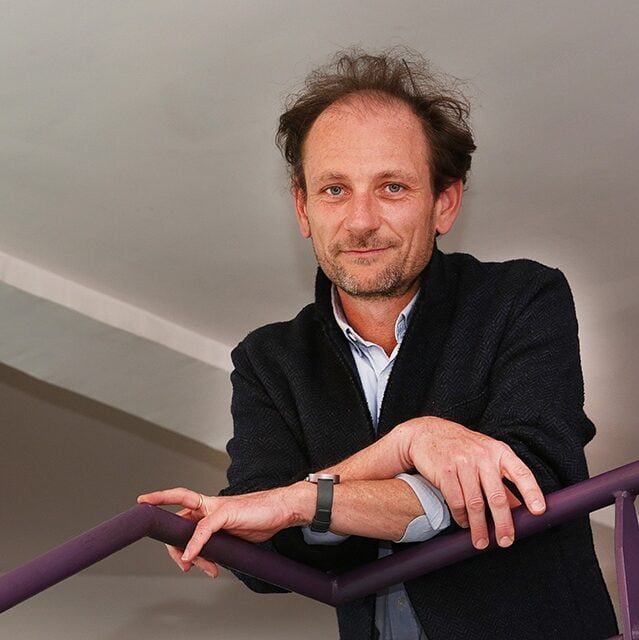
Can you present the impact of your work on the Grand Site de la Dune du Pilat?
My contribution is on two very different levels.
In 2018, I carried out expert work, shared with a whole working group bringing together elected officials, technicians, and a wide variety of organizations that are closely or remotely partners of the Mixed Syndicate. The objective was to carry out a prospective approach opening on a perspective of evolution of the management of this great site of nature.
The other level of intervention is much more prosaic but no less important. It’s that of detail. My mission consisted of supporting the Union in the development and monitoring of the project to requalify the reception area. This is surprisingly small compared to the immensity of the site and the number of visitors. It is this contrast that makes the work accomplished to organize the reception of the public in such a small and fragile space remarkable.
My work consisted of supporting the Union, formulating opinions, asserting choices to influence the project management, for example for the rehabilitation of the village of cabins or in terms of interpretation. The goal was to ensure consistency and maintain overall harmony.
Concerning the exterior spaces, my intervention was even more concrete. The focus was on reconfiguring the parking lot to improve it and refresh it. It actually receives a lot of people compared to its size (editor's note: during the July-August attendance peaks and the May bridges). We had to think about bus parking, so that they are less in contact with all the pedestrian flows, with the arrival of bicycles which are increasingly present, notably with the development of electric bicycles. It was necessary to improve the comfort, visibility and enjoyment of the pedestrian visitor in general (this work lasted two years between 2021 and 2023, the inauguration took place on June 30, 2023).
If we bring these interventions back to the issue of landscape, we can make a comparison with music. The operation of the planning of a territory is generally sectorized, each one works in his specialized field as each musician plays his favorite instrument. But if there is no common score, the music will be inaudible. The same goes for the layout, you have to write and share a common score for the harmony of the site which is unique.
What message do you want to convey to visitors?
You are going to visit a truly wonderful site. It's wonderful to get out of the trees and then to find yourself facing the white wall that stands in front of you, it's fantastic to find yourself at the top and have this horizon on this double ocean that we were talking about: the real one and the one forest, and in its very pure and virginal dimension. But, you don't know anything about it yet when you did that.
Go survey the dune in its length. You have a lot to discover by spending time on the site.
Take time to discover more all the facets of the dune, right up to the ocean's edge, up to the more terrestrial facade of the dune, which is the most spectacular, because we can see it advancing in the forest, dry the trees. It is absolutely magnificent.
And then also, take an interest in the forest. It is a very special forest in the classified site. It is a used forest, with a history and a unique aspect.
The average discovery time is striking. 80-85% of people spend less than 3 hours on the site. It is very quickly consumed. In fact there is a lot to discover, to go through but it is not known enough.
You have to get in the mood.
We must gradually experiment with other forms and other ways of simultaneously accessing, browsing and discovering the site in order to encourage visitors to understand it differently, to devote more time to it, to to impregnate, to permeate.
What is your view on the 15 years of public management?
It is one of the most frequented sites in France, on one of the most restricted reception areas there is. If I compare the number of m2 occupied for reception and the number of visitors, we can say that it is remarkably managed. This also translates into very high visitor satisfaction rates.
But it comes at the cost of a lot of work. Many seasonal workers have to be hired in order to make the reception area work in the summer. Unauthorized parking must be fought, which poses problems (risk of fire, trampling, illegal dumping of waste).
Seeking to manage this ever-increasing attendance in a qualitative manner also raises many questions. The expert work carried out seeks to bring out answers by broadening the field of possible actions, seeking to diversify the modes of discovery and the visit routes. Beyond the requalification of the reception area, we must quickly think of the site differently to tell a broader story for those who love the Dune and know it but also for those who are just passing through.
What would you like to add that you would not have expressed when answering the previous 4 questions?
If we want this to be less under pressure, work which will be long, must be started, which envisages the site of the Dune and its reception in a much larger space: from Arcachon, La Teste-de- Buch, Cap Ferret, Petit Nice. It is a programming work which involves land, which mobilizes other actors. What do we want to tell about the history of the dune? What do we want visitors to read about this story upon their arrival, during their visit and remember when they return? It is this approach which is interesting, it will reinforce the size of the site which is probably one of the first points of attractiveness for a population of urban territories where space is much rarer.
It is this story, the outcome of which is access to the highest point of the dune, that we must continue to write, chapter by chapter. This is not contradictory. I imagine an operation which in winter would be quite different from that in summer. For peaks in attendance, this other mode of operation, complementary to the reception area, must be considered and gradually implemented. And we can bet that this will only be beneficial for the territory more generally. It is also a way of being less of an express consumer of natural spaces, which is in the spirit of the Grands Sites de France. To lengthen is to slow down. It is a relationship to time, as well as to space.








